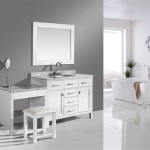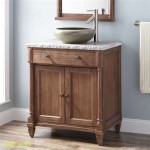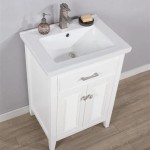Bathroom Mirrors for Double Vanity: A Comprehensive Guide
Selecting the appropriate bathroom mirrors for a double vanity is a crucial decision in bathroom design. The mirrors not only serve a practical function but also significantly contribute to the overall aesthetic and perceived size of the space. Proper consideration of size, shape, style, lighting integration, and installation requirements is essential to achieving a functional and visually appealing bathroom environment. This article provides a comprehensive overview of the factors to consider when choosing bathroom mirrors for a double vanity.
Sizing and Proportion
Determining the correct size of bathroom mirrors for a double vanity involves several considerations. The primary factor is the width of the vanity itself. Typically, the combined width of the mirrors should not exceed the width of the vanity. However, the specific configuration can vary depending on the design intent. For instance, two separate mirrors, each corresponding to a sink on the double vanity, are a common choice. In this case, each mirror's width should be proportional to the sink it serves. A general rule of thumb is to size the mirror slightly smaller than the space it occupies above the sink, allowing for a comfortable and balanced visual. The height of the mirror is equally important. It should be tall enough to accommodate the height of most users in the household. A common starting point is to position the bottom edge of the mirror approximately five to ten inches above the backsplash, and the top edge at a comfortable viewing height.
Consideration must also be given to the relationship between the mirror and other bathroom fixtures, such as light fixtures. The placement of lighting above or beside the mirror can influence the perceived size and shape of the mirror. If sconces are planned on either side of the mirror, the mirror's width needs to accommodate the space taken up by the lights. Similarly, if a light fixture is mounted above the mirror, the height of the mirror should allow for sufficient clearance between the top of the mirror and the bottom of the light fixture.
Ultimately, the ideal size of the bathroom mirrors for a double vanity is a balance between functionality and aesthetics. It's helpful to visualize the mirrors in the space or use design software to create a mock-up of the bathroom. This can help in making an informed decision about the appropriate size and proportion of the mirrors.
Shape and Style Considerations
The shape and style of bathroom mirrors contribute significantly to the overall aesthetic of the bathroom. The shape of the mirror can dramatically alter the perceived dimensions of the space. For example, a rectangular mirror can make a narrow bathroom appear longer, while a round or oval mirror can soften the lines of a more angular bathroom.
Rectangular mirrors are a popular and versatile choice for double vanities. They provide a generous viewing area and can be installed horizontally or vertically, depending on the design preference. Square mirrors offer a clean and modern look, suitable for contemporary bathrooms. Round or oval mirrors add a touch of elegance and can be a focal point in the bathroom. Arched mirrors introduce a sense of sophistication and can complement traditional or transitional bathroom styles.
The style of the mirror should complement the overall design of the bathroom. Framed mirrors offer a more traditional or decorative look, while frameless mirrors provide a sleek and minimalist aesthetic. The frame material can also influence the style of the mirror. Wooden frames add warmth and natural texture, while metal frames offer a more modern or industrial look. Chrome, brushed nickel, and oil-rubbed bronze are common metal finishes that can coordinate with other bathroom hardware. Consider the existing finishes in the bathroom, such as faucets, cabinet hardware, and lighting fixtures, to ensure a cohesive design.
Beyond the basic shape and frame, other stylistic elements can be incorporated into bathroom mirrors. Beveled edges add a touch of elegance and reflect light, creating a more visually appealing effect. Decorative accents, such as etched designs or mosaic tiles, can add personality and visual interest. Lighted mirrors, which integrate LED lighting directly into the mirror, offer a modern and functional option, providing ambient lighting and eliminating the need for separate light fixtures above or beside the mirror.
Lighting Integration and Functionality
Effective lighting is essential in any bathroom, and the integration of lighting with bathroom mirrors is a critical aspect of bathroom design. Proper lighting ensures adequate visibility for grooming tasks and contributes to the overall ambiance of the space. There are several options for integrating lighting with bathroom mirrors, each offering different advantages.
The most common approach is to install light fixtures above the mirror. These fixtures provide direct illumination onto the face, minimizing shadows and enhancing visibility. Sconces mounted on either side of the mirror offer a more balanced and flattering light, reducing shadows and creating a more even illumination. When selecting light fixtures, it's important to consider the type of bulb and its color temperature. LED bulbs are energy-efficient and long-lasting, and a warm white color temperature (around 3000K) is generally preferred for bathrooms, as it provides a comfortable and natural light.
Lighted mirrors, which integrate LED lighting directly into the mirror, are becoming increasingly popular. These mirrors offer a sleek and modern look, and they provide ambient lighting that is both functional and aesthetically pleasing. Lighted mirrors come in various styles, including backlit mirrors, which emit light from behind the mirror, and edge-lit mirrors, which have LEDs embedded along the edges of the mirror. These mirrors often feature dimming capabilities, allowing users to adjust the brightness to their preference.
In addition to providing direct illumination, bathroom mirrors can also enhance the overall lighting scheme of the bathroom by reflecting light. Mirrors can amplify natural light from windows or skylights, making the space feel brighter and more open. They can also reflect artificial light from other fixtures, creating a more layered and dynamic lighting effect. The placement of mirrors in relation to other light sources is therefore an important consideration in bathroom design.
Functionality is also a key aspect of lighting integration. Consider the primary uses of the bathroom and select lighting that meets those needs. For example, if the bathroom is used for makeup application, bright and even lighting is essential. If the bathroom is primarily used for relaxation, softer and more ambient lighting may be preferred. Dimming capabilities can be particularly useful in bathrooms, allowing users to adjust the lighting to suit their needs.
Installation Considerations
Proper installation is crucial for ensuring the longevity and safety of bathroom mirrors for a double vanity. The installation process can vary depending on the type of mirror and the wall material. Before beginning the installation, it's important to carefully measure the space and plan the placement of the mirrors. Ensure that the mirrors are centered above the vanity and that they are level. Consider the height of the users and position the mirrors accordingly.
For framed mirrors, the installation typically involves mounting the mirror onto the wall using screws and anchors. The type of anchor depends on the wall material. For drywall, drywall anchors are commonly used. For tile or concrete walls, masonry anchors are required. It's important to use anchors that are rated for the weight of the mirror to prevent it from falling. When drilling into tile, use a specialized drill bit designed for tile to avoid cracking the tile.
Frameless mirrors can be more challenging to install, as they do not have a frame to support them. Typically, frameless mirrors are attached to the wall using mirror mastic or adhesive, in combination with clips or mounting brackets. The adhesive is applied to the back of the mirror, and the mirror is pressed firmly against the wall. The clips or brackets provide additional support and prevent the mirror from slipping while the adhesive cures. It's important to use a mirror-specific adhesive that is compatible with the mirror's backing material and the wall surface. Follow the manufacturer's instructions carefully when applying the adhesive.
For lighted mirrors, the installation requires electrical wiring. It's essential to hire a qualified electrician to handle the electrical connections. The electrician will need to run wiring from the electrical panel to the location of the mirror and connect the mirror to a junction box. Ensure that the wiring is properly grounded and that all electrical connections are made safely. It's also important to comply with all local electrical codes and regulations.
Finally, after the mirrors are installed, inspect them carefully to ensure that they are securely mounted and level. Clean the mirrors with a glass cleaner and check for any imperfections or damage. If any issues are found, address them promptly to prevent further problems. Proper installation will ensure that the bathroom mirrors for your double vanity are both functional and aesthetically pleasing for years to come.
Material and Durability
The material composition of bathroom mirrors significantly impacts their durability and longevity, particularly in a humid environment. Selecting mirrors crafted from high-quality materials ensures resistance to moisture damage, corrosion, and deterioration over time. The glass itself is a primary consideration. Opting for low-iron glass provides a clearer and more accurate reflection compared to standard glass, which can have a slight green tint. This enhanced clarity is particularly beneficial for tasks requiring precision, such as makeup application or shaving.
The backing of the mirror is equally important. A robust and moisture-resistant backing prevents delamination, a common issue where the reflective coating separates from the glass due to moisture exposure. Silvered mirrors with multiple protective coatings offer superior resistance to corrosion and humidity compared to aluminum-backed mirrors. These coatings typically include layers of copper, which enhance the adhesion of the silver to the glass, and a final protective layer that shields the silver from oxidation and moisture.
For framed mirrors, the frame material plays a crucial role in durability. Solid wood frames, particularly those made from hardwoods like maple or oak, are resistant to moisture and warping. However, they require proper sealing and finishing to prevent water damage. Metal frames, such as stainless steel or aluminum, are inherently resistant to corrosion and rust, making them ideal for humid bathroom environments. These metals can be finished with powder coating or plating to enhance their appearance and provide additional protection against scratches and wear.
The quality of the mirror's edges also contributes to its durability. Polished edges are smoother and less prone to chipping or cracking compared to raw, unfinished edges. Beveled edges not only add a decorative touch but also protect the edges from damage. Furthermore, sealing the edges of the mirror with a waterproof sealant can prevent moisture from seeping between the glass and the backing, further extending its lifespan.
By carefully considering the materials used in the construction of bathroom mirrors, homeowners can ensure that their mirrors will withstand the challenges of a humid bathroom environment and provide years of reliable service. Investing in high-quality materials is a worthwhile investment that can prevent costly replacements in the future.

Thin Metal Frame Double Vanity Mirror 60 X 30 Aged Brass

Double Vanity Rounded Rectangle Metal Framed Mirror Brushed Nickel 54 W X 30 H French Cleat

15 Stunning Bathroom Mirror Ideas For Double Vanity Spaces
9 Bathroom Mirror Ideas You Ll Love Signature Hardware

Luxhomez 24 In W X 36 5 H Arched Aluminum Bathroom Wall Mounted Vanity Mirror 2 Pieces Lgzm 61 2go 2a The Home

Side Lighted Led Bathroom Vanity Mirror 30 X Square

10 Ideas For Double Vanity Bathroom Mirrors That Are A Ok
9 Bathroom Mirror Ideas You Ll Love Signature Hardware

Boyel Living 60 In W X 36 H Large Rectangular Frameless Anti Fog Led Light Wall Mount Bathroom Vanity Mirror Ex Dj217 38x72 The Home

How To Create A Prep Station For On The Go Mornings







